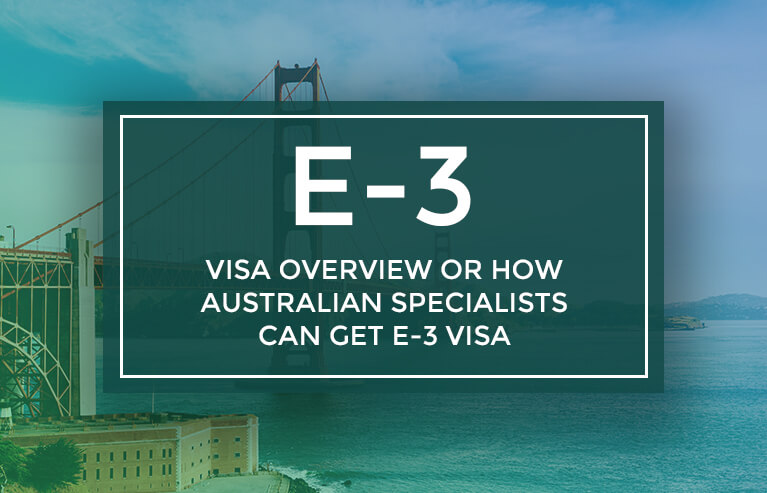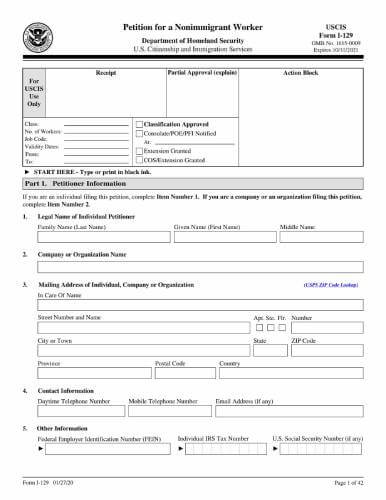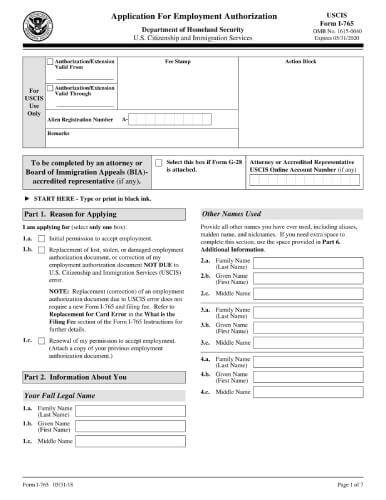E-3 Visa was established by the REAL ID Act of 2005. The third visa in E-classification can be issued for the specialty occupation categories of the nationals of Australia that are going to the U.S. for work.
People that are qualified for the E-3 visa classification are Australian nationals that are seeking employment as highly qualified specialists. The foreigner should possess a bachelor’s degree or higher. If you are an Australian citizen, work in the related profession, and would like to work in the U.S., you can apply for E-3 Visa.
Each non-immigrant Australian citizen that already works in the U.S. on a legal basis can change their status to the E-3 specialty worker. He or she can also apply for an E-3 visa in order to extend their stay in the U.S.
The E-3 visas cannot be valid for more than 2 years after the initial approval. But you may apply for E-3 Visa extension, if you’re still working in the U.S. Your employer must receive labor condition application (LCA) with a new validity date and file the I-XNUMX form to the United States Citizenship and Immigration Service (USCIS). You should also send the I-XNUMX form there for the visa extension or changing the status.
A yearly cap for E-3 Visa is 10,500 new workers. New E-3 workers can be classified as:
- Foreigners that are admitted initially in E-3 classification;
- Foreigners that change their non-immigrant status to E-3 classification;
- Foreigners that change employers while in E-3 status.
Any family member that enters the U.S. with E-3 Visa and at the same time is your spouse, can work in the U.S. after receiving work authorization (EAD).
Any Australian citizen outside the U.S. that wants to be admitted at the U.S. Port-of-Entry must have a valid E-3 visa issued by the U.S. Department of State.
Any Australian citizen that already works in the U.S. may request the change of status to E-3 or extend their E-3 visa status. The foreigner should file the Petition for a Non-immigrant Worker (Form I- 129) directly with the USCIS Vermont Service Center.
The cost of filing the Petition for changing your status to E-3 or visa extension amounts to $460.
Visa applicants must add the following documentation to the Form I-129:
- A valid passport as a proof of the Australian nationality;
- Letter from the U.S. employer with a detailed description of the foreigner’s occupation, duties, and salary;
- A certificate that the foreigner has a bachelor’s degree or higher (or its equivalent in the specific specialty occupation) to meet the requirements of the mentioned position;
- Evidence that the foreigner meets all occupational requirements for possessing the position;
How to file for the E-3 Visa for the specialty occupation pros from Australia
A special visa program was created under the Free Trade Agreement AUSFTA for highly qualified Australian nationals that would like to work in the U.S. By using electronic visa of the third category, the employers from the U.S. can hire Australian professionals as the “specialty workers”. It allows us to employ them on a temporary basis. This visa is only valid for the term up to two years upon release. But there can be indefinite renewals or extensions, every two years.
Australian nationals that meet the criteria of the E-3 category will find this option more preferable than the H-1B status. Especially those of them that haven’t had issues with a dual intent before!
The prospective U.S. employers don’t need to prove that they can’t find suitable specialty workers inside of the U.S. or somehow demonstrate it. Therefore, the process simplification allows deploying Australian specialty workers in short order by applying for E-3 Visa at the U.S. Consulate.
The E-3 procedure bypasses the USCIS-related petition and can be completely done at the U.S. Consulate abroad. It resembles the Treaty Investor/Trader visa rather than the H-1B.
The E-3 visa application procedure is the same as the application procedure for any labor visa in the U.S.
- The prospective employer should receive the LCA from the Department of Labor. If the employer has done it before, chances are the LCA has already been received. The employer must provide evidence of safe work conditions for foreign employees. They also should demonstrate that they pay a competitive salary.
- The foreigner should complete the online form for the DS-160 Non-immigrant Visa. It can be found at the web-site of a local U.S. Consulate or U.S. Embassy.
- The foreigner must go through the interview for an E-3 visa at the U.S. Consulate in the home country. The consulate officer will check the information indicated in the E-3 Visa application, including the information about the foreigner’s work in the U.S.
Although the LCA is pretty over-regulated, the employers have an efficient and valuable tool for boosting their competitiveness. With E-3 visas, they can employ Australian professionals quickly and with a little effort on their part.
Stated by the Congress, the quota of 10500 E-3 visas per year has never been reached.
It is interesting to note that qualified specialists from Australia have a worthy alternative to E-3 to get a legal employment status in the United States for them as well as their family members.
E-3 Visa allows employers from the United States to hire Australian pros or specialty workers for certain positions. The U.S. employer may be the individual or business entity with the ability to engage the Australian native to work in the U.S. employer should control that person’s work and have a tax ID number. Such a definition of the U.S. employer allows the foreigner to be hired by the entity that will control the working activity while getting payments from another entity. For example, it can be the foreign branch of the U.S. employer.
The requirements for the candidate employee are the possessing of highly specialized knowledge and its confirmation with a bachelor’s degree or its equivalent. The position that is considered to be a specialty occupation has to meet the following requirements according to the USCIS rules:
- A bachelor’s degree or it's equivalent;
- The requirement of the employer to the degree is the same as in other entities;
- The degree is typically required for such positions;
- The specific duties require knowledge that the foreigner must hold.
The “specialty occupation” includes but not limited to accounting, architecture, business specialties education, engineering, journalism, law, mathematics, medicine and health, social sciences, veterinary science, and many more.
Qualifications Requirements for the Specialty Occupation
Each certain specialty occupation has the qualification requirements according to the rules in effect. A prospective employee must have a relevant license, proper degree or its equivalent, and acquired expertise in this specialty through a number of previous positions.
The equivalent of an advanced degree can be confirmed through the following means:
- Evaluation by the academic official based on the field experience;
- Successful examination on a college-level;
- Confirmation that the education abroad is equal to the U.S. requirements for this degree;
- The certificate issued by national professional organizations;
- The USCIS’ rule that a prospective employee has enough knowledge, training, and work experience to be equal to the degree.
In order to clear the last point. If the prospective employee doesn’t have a bachelor’s degree, the State Department and USCIS agree that 3 years of training and work in the field are equal to one year of college-level education and 5 years of a post-bachelor’s experience are equal to a master’s degree. This alternative has turned out to be very useful for many prospective employees.
LCA
The employer should receive LCA from the U.S. Department of Labor for the E-3 applicant. The LCA application contains:
- position’s title;
- salary;
- location;
- term of employment;
- prevailing wage rates.
The employer must confirm that the E-3 employee is offered a higher salary than is paid for similar positions, all employees work under similar conditions, the position is not affected by a strike or lock-out that may happen at the workplace and other employees have also been provided with a copy of LCA.
The determination of the wage system may be backed with various alternative methods. They include federal labor laws, a private wage system, a prevailing wage determination by a State Employment Services Administration, or an interval-survey carried out by the employer.
During the E-3 employee’s term of employment and after it, the employer must keep certain documents within a public inspection file. They must be provided to individuals that have labor claims related to E-3 visa on demand.
The file must contain the following documents:
- Copy of LCA;
- Payable wage rate of the E-3 employee;
- Method of determination of a payable wage rate of the E-3 employee;
- Prevailing wage determination;
- Copy of the E-3 petition;
- Benefits the U.S. employees receive in the same occupation category as the E-3;
- In case of an acquisition, merger, or another restructuring process in the entity, the document shows that the employer has agreed to assume all obligations of a prior employer regarding the E-3 petition.
USCIS Petition
Any U.S. employer is able to hire a person with an E-3 visa. During the application process, the U.S. employer has to get LCA from the State Department. The prospective employee has to fill and submit the online DS-160 application form, pay the MRV application fee which amounts to 205$, and pass the interview at the U.S. Consulate. The U.S Embassy is situated in Canberra, and the U.S. Consulates are located in Sydney, Perth, and Melbourne.
However, if the prospective employee is already in the U.S. in a non-immigrant status other than E-3, he or she can file a petition for the E-3 change of status to the USCIS. The disadvantage of this method is that the foreigner can’t get to work prior to the approval. And this process can cause a significant delay. But still, this method is suitable if the foreigner is already in the U.S. in a non-immigrant status and needs to stay in the U.S. for some reason. This method may also be useful for the employee’s E-3 status extension.
E-3 Visa Extensions
The U.S. employer may request an unlimited number of two-year extensions. However, E-3 provides a temporary status. Thus, employers must prove that the services of the Australian pros are still required. Otherwise, the USCIS or the U.S. consulate abroad may reject any further extensions. Moreover, it’s prohibited to appellate for revising of the extension rejections. The State Department prohibits the appeals of visa denials.
Cap Issues Overview
The Congress-imposed yearly cap is 10,500 E-3 visas. But it is not being taken into account when:
- the employer is keen on extending a previously approved E-3 petition;
- the employer wants E-3 Visa to be re-issued due to a job change.
The cap doesn’t include E-3 Visas that were issued to other family members. However, if the E-3 employee decides to change his/her employer, the cap remains. It should be mentioned, that the E-3 visa category was established in 2005. Since that time, the E-3 cap has never been reached. It is the strongest argument why the Australian pros consider this type of visa a better option than the H-1B.
The E-3 employee can change an initial employer during the duration of the petition grant. However, taking a new position is halted until either a new employer’s E-3 petition is being approved or the employee gets back home, re-applies for the visa, and returns to the U.S. in E-3 status for new employment.
Employment terms
The E-3 employee must leave the U.S. when the employment is terminated, regardless of whether it is desirable or not. The U.S. employer is not obliged to compensate for the transport costs. In case the E-3 employee finds a new job, the E-3 Visa application must start from the beginning.
The USCIS considers that when the work contract finishes, the E-3 employee becomes out of the status and therefore, should leave the U.S. There is no grace period! The employee must leave immediately in order to not impact the immigration benefits in the future. Immigration counseling can be of great assistance under such circumstances.
E-3 status doesn’t entail the dual intent when a non-immigrant intends to become a permanent resident of the U.S. Individuals that are looking to be admitted with the E-3 status, need to abandon the intention that they enter as future immigrants. In witness whereof, the foreigner must declare that he or she will leave the U.S. when the authorized stay under the visa will be expired.
However, the proof of residence in Australia isn’t required as the confirmation of a non-immigrant intention!
In such cases, when the employee has a dual intent, he or she should opt for a non-immigrant status that provides such an option.
How can Dependents enter the U.S?
The E-3 principal’s family members can come and reside in the U.S. for the entire period, regardless of their nationality. A dependent spouse may seek employment after completing the I-765 form with the USCIS. Children cannot be employed.
Moreover, the E-3 Visa holder’s spouse may get E-3 or another employment status independently.
The E-3 dependents can also opt for B-1 Visa for business visitors or B-2 Tourist Visas. For these visas, the employment is not required.
FAQ’s
How long does it take to complete the consideration of the E-3 Visa application?
It takes 3-8 weeks to process the application. However, waiting times may vary greatly depending on your local U.S. Embassy.
Can the spouse of the E-3 principal foreigner be employed in the U.S.?
Yes, the spouse must file the I-765 Form with the USCIS for EAD.
Does E-3 status equal to a permanent residence in the U.S. for the Australian citizen?
E-3 status must be renewed once in 2 years. But the number of renewals is unlimited.
What is a yearly cap of E-3 visas?
The cap is 10,500 visas per year. In fact, this limit has never been reached.


 Form I-129 | Petition for a Nonimmigrant Worker
Form I-129 | Petition for a Nonimmigrant Worker
 Form I-765 | Application for Employment Authorization
Form I-765 | Application for Employment Authorization